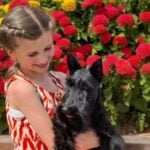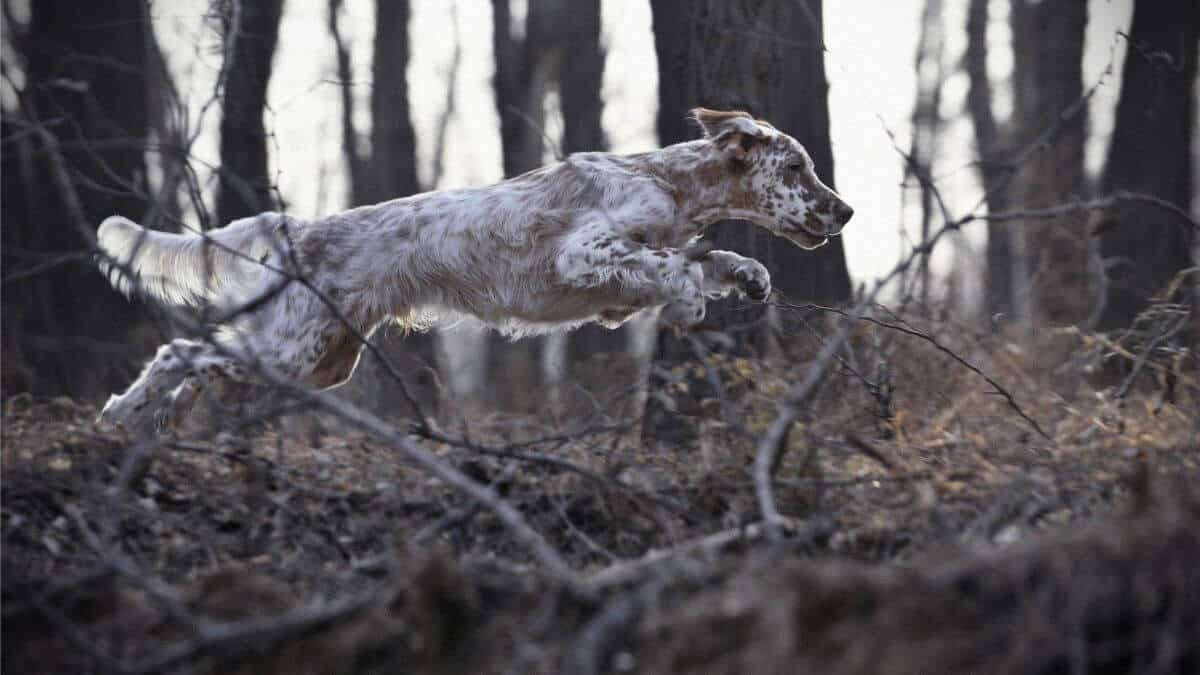
Home » Judging the English Setter

This article was originally published in Showsight Magazine, June 2020 issue.
To evaluate the English Setter, one must first understand the similarities and differences in the four Setters. These differences arise from the purpose of each breed and why they were developed as individual breeds.
All Setters were bred as upland gun dogs—birds that are either pointed or flushed on land—versus ducks or water birds. Originally, Setters accompanied hunters on foot, working the bird field fairly close and within shot range. The dogs would find the birds and “set” or crouch, allowing hunters to throw nets over both the quarry and the dogs—thus the term “Setters.”
This concept is really important as you can imagine these dogs need to get down between their shoulder blades. The breed differences come mainly from country of origin and the terrain they hunted over as well as the breeds and breeders who developed each. The Irish and the Red and White, (think Ireland) come from rolling ground, the Gordon (think Scotland) from rugged craggy ground, and the English (think England) over moderate terrain. All these dogs represent their owners and breeders as well; the Irish Red and White with a rollicking personality, the Gordon with a more dour outlook and the English with a serious, dignified way. So if you start by thinking Setter in general then you can begin to understand each breed.
For the purpose of this article we will concentrate on the English. We know that there were Irish-English crosses in the mid 1800s. By the late 1800s there were two distinct strains of English Setters, the Lavarack and the Llewellyn, both named after the gentlemen who developed them; the first as the bench type or show dog, the second as the field type. Today, the modern Lavarack English is further away from that original dog than perhaps in the early 1900s as we see a more stylish, trimmed animal that to the eye stands out in the ring. We will concentrate on this modern dog, but do remember they both can hunt and they originally came from the same genetic stock. The ES is a well-balanced, moderate, elegant gun dog, but with no part to show exaggeration. There should be no part out of balance—no necks like Giraffes or heads plopped straight onto shoulders, no bodies a mile long, no legs too short or too long, no straight front and over-angulated rears—I am sure you get the picture! His head is not as lean as the Irish, nor as deep and wide as the Gordon, but shows parallel planes as the others. He has a definite stop and occiput and a lovely dark, almost round eye, well-set. Full pigmentation of the eye and lips is important as it is essential in creating that wonderful, soft expression. The head should be in balance with the rest of the dog and neither underdone nor overdone. These are scenting animals so it is important to have good noses and straight nasal bones.
A lean, arched neck should lead into well-laid-back shoulders. Front and back assembly must match for the dog to be well-balanced, with good angulation in both the front and rear being ideal but often lacking. Abrupt, steep shoulders create a pounding movement that is far from effortless, and the same can be said for short upper arms. This issue is common in most Sporting dogs.
I am thrilled when I find a correctly assembled front and rear. As a fellow Setter judge recently commented to me: “If you find that, run to the table and throw them every ribbon you have!”
A chest with fill in the front and depth to the elbow provides the lung room needed for a dog hunting hard all day. Ribs should be well-sprung but not barreled, and they need to be carried back with a short loin to ensure efficient movement. This correct assembly results in an oval appearance when viewed from above. A wide thigh is a plus.
Our standard does not provide height-to-length measurements, but balance is key—too short or too long in body distorts the overall look, just as legs that are too short or too long do. However, it is important not to dwell on individual pieces and parts but to judge the whole dog. Still, the summation of those pieces and parts is what makes the dog.
Might I mention again how important it is to reward animals with correct assembly?
We ask for medium bone and good feet, which are essential for hunting, as well as short hocks that allow the dog to propel itself with ease. Tails, as extensions of the spine, should be straight off the back and lively, long enough to reach only the hock, and taper from the set.
This does not mean a flag flying in the breeze nor a tail pointing to the head. Unfortunately, incorrect tails have become the norm. If the croup is correct, it would be almost impossible to have an incorrect tail carriage. Look at the dogs in the accompanying pictures—those tails could not be elevated.
If the dog is well-balanced, he will move with ease and effortlessly, demonstrating good reach and drive, both down and back and around. Coming and going should show good flexion of the hocks with no weaving or crossing of legs or feet. From the side, it is essential that the back remain quiet and firm, indicating balance in both the fore and aft assemblies. Movement is a test of construction. Remember, we are not selecting the best mover but rather the best type who moves well.
The English Setter is a single-coated dog with a straight to slightly wavy coat. He should exhibit a topcoat of some length to protect the body in the field, with feathering in all the usual places. It is permissible to use a clipper on the face, the top of the ears, and under the neck down to the point of the chest, but never on the back. A soft, wooly coat is incorrect, as is excessive length, which does not align with the purpose of the breed. This is fundamentally a hunting dog, and emphasis should be placed on this function. If faced with a choice between two equal dogs, I would not let exquisite grooming or coat length dictate my decision, but rather the dog’s suitability to perform its job.
The ES is basically a white dog with ticking in various degree of orange (brown), blue (black), lemon, liver and tricolor (black, tan and white). These degrees can range from very white to very dark (roan). There is no preference in colors when judging, although dark patches are not preferred anywhere other than the head.
I personally caution you to remember that color is only a part of your evaluation of the dog. One of the most wonderful things about this breed is the variety of those permitted colors. There has been discussion about body patches, and my personal recommendation is this: patching has always been inherent in the breed, especially in the field variety, so please fault accordingly.
I feel personally involved in the color issue. I had a dark tri-colored male with some patching who had a head and wonderful body to die for. I was reluctant to use him because he was so dark and would have preferred to use his open tri brother. Alas, the open tri dog never could sire a litter.
When we then used the dark tri male, he produced the most wonderful heads and bodies—yes, the darkness and patching occasionally showed up, but I wouldn’t trade anything for what he gave the breed. Personally, I can’t think of a breeder who has deliberately bred for patching. I also hope that no one would eliminate a patched dog with wonderful attributes from their breeding program.
Though the breed has been around for a long time, you may have trouble finding English Setters to view. (We share a low number on the list of popularity—usually around 65.)
We don’t mind this, but as you can imagine, it can present a challenge for new judges. It is important to attend specialties to see good examples in numbers. We do have dedicated breeders, but our litters tend to be small, and puppies are usually pretty fragile in the beginning, which is odd for a large dog. The reproduction rate is not always a given, and I find that artificial insemination—either frozen or extended—does not work very well.
Our health issues include deafness, hip and elbow issues, and thyroid problems. However, our dogs generally live a long life of 13 to 15 years. We have an active health committee and work hard to address these issues. In summation, the English Setter should greet you with a soft wag of his tail and extend his head into your hand. He is a sweet, loving companion who will curl up on the sofa after a hard day of hunting. He should never be aggressive, shy, or exhibit any temperament other than that of a wonderful, friendly dog. He is loving of children and makes a wonderful family dog.
He is most often exhibited by his inexperienced owner-handler, so please be forgiving and encouraging to them, as we want their experiences to be positive. I hope this helps you in your evaluations of our wonderful breed and that you enjoy your time in the ring with him!